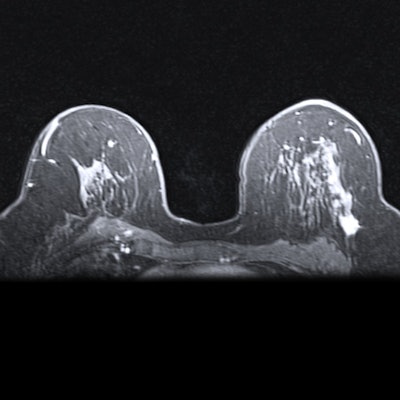
Breast MRI can produce more false positives on initial screening in women at higher cancer risk -- an outcome many consider a "harm" -- but patients and their doctors may decide this is justified by the modality's higher cancer detection rate, according to a study published May 15 in Clinical Imaging.
The study results could help clinicians put MRI in perspective when using it for breast cancer screening, study lead author Dr. Jessica Hayward of the University of California, San Francisco told AuntMinnie.com via email.
"Women at our institution were more likely have an abnormal result and biopsy at their initial screening MRI, but cancer detection was also significantly higher," Hayward said. "After the initial breast MRI, the likelihood of an abnormal interpretation, biopsy, and cancer decreased. We hope these results will help our referring providers counsel high-risk patients on the likelihood of recall and potential need for additional testing before their first breast MRI is performed."
Supplemental breast cancer screening with MRI is recommended by a number of professional societies for women at higher risk of the disease due to the modality's high cancer detection rate compared with mammography and ultrasound. But it can also produce higher rates of false positives at first screening, begging the question of whether the modality's benefits outweigh its "harms", the group noted.
To address the question, Hayward's team included 310 dynamic, contrast-enhanced breast screening MRIs performed between 2013 and 2015 and divided them into two groups: initial screens and subsequent screens (the latter had at least one prior MRI for comparison). Of the 310 MRIs, 71 were initial screens and 239 were follow-up screens. The investigators confirmed malignant exams by pathology and benign cases by pathology or clear one-year follow-up.
The most common reason for initial MRI exams was a family history of breast cancer (34%), while the most common reason for subsequent exams was a personal history of breast cancer (48%), according to the group.
Of the total MRI exams included in the study, 27% were read as abnormal, Hayward and colleagues found. The risk of abnormal interpretation was 1.5 times higher in the initial screening group compared with the subsequent screening cohort, and the risk of biopsy was 1.7 times higher. But the researchers also found a 1.5 times higher cancer detection rate at the initial exam compared with subsequent ones, as well as higher sensitivity rates.
| Breast MRI performance, initial exam compared with subsequent exam | |||
| Performance measure | Initial breast MRI screening exam | Subsequent breast MRI screening exam | p-value |
| Cancer detection rate per 1,000 exams | 85 | 29 | 0.08 |
| Abnormal interpretations | 52% | 19% | <0.001 |
| Negative predictive value | 100% | 99.5% | -- |
| Positive predictive value | 17% | 14.9% | -- |
| Positive predictive value of biopsy | 17% | 20% | 0.99 |
| Rate of biopsy | 49% | 15% | <0.001 |
| Sensitivity | 100% | 88% | -- |
| Specificity | 55% | 83% | -- |
Even at initial screening, breast MRI's high cancer detection rate may outweigh its potential for false positives, according to Hayward.
"Just as with screening mammography, a higher abnormal interpretation rate is to be expected at the initial screening round with breast MRI," she said. "Patients should be reassured that the false positive rate should decline with subsequent screens."
The fact that breast MRI's performance on subsequent screening improves with access to a prior MRI bolsters its benefit, the team concluded.
"Since the number of abnormal interpretations and biopsy rate both decrease on subsequent screens, this makes continued screening more tolerable for high-risk patients and also supports the importance of having prior MRI images for comparison to decrease false positives," it said.





















